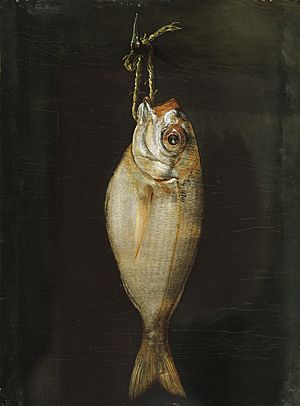Bartolomé Montalvo facts for kids

Bartolomé Montalvo (born 1769 – died 1846) was a talented Spanish painter. He was born in a town called Sangarcía, near Segovia, Spain. Montalvo became known for his beautiful paintings of landscapes, animals, and especially still lifes. Still lifes are paintings that show objects like fruit, flowers, or food. In Spain, these types of paintings are called bodegones.
Contents
Early Life and Training
Bartolomé Montalvo began his art journey by studying with another painter named Zacarías Velazquez. This training helped him develop his skills.
Becoming a Royal Painter
In 1814, Montalvo was accepted into the Real Academia de Bellas Artes de San Fernando. This was a very important art school and academy in Spain. Just two years later, in 1816, he became a "pintor de cámara" for King Fernando VII. This special title meant he was an official painter for the King, creating art for the royal family and their palaces.
His Artistic Style
Montalvo was especially good at painting three main types of art:
- Landscapes: These paintings showed natural scenes like mountains, rivers, and forests.
- Hunted Animals: He often painted animals that had been hunted, showing them in a realistic way.
- Still Lifes (Bodegones): As mentioned, these were paintings of everyday objects, often food or kitchen items. His painting of a bream (a type of fish) is a famous example.
Later Years and Legacy
Bartolomé Montalvo continued to be an important figure in the art world. For many years, he served as the lieutenant director of the Real Academia de Bellas Artes de San Fernando. He passed away on August 11, 1846, leaving behind many wonderful artworks.
See also
 In Spanish: Bartolomé Montalvo para niños
In Spanish: Bartolomé Montalvo para niños

